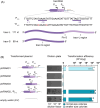Cas9-independent tracrRNA cytotoxicity in Lacticaseibacillus paracasei
- PMID: 40727907
- PMCID: PMC12302355
- DOI: 10.1093/femsml/uqaf013
Cas9-independent tracrRNA cytotoxicity in Lacticaseibacillus paracasei
Abstract
CRISPR-Cas9 systems are widely used for bacterial genome editing, yet their heterologous expression has been associated with cytotoxicity. The Cas9 nuclease from Streptococcus pyogenes (SpyCas9) has been one common source, with reports of cytotoxicity with the nuclease alone or in combination with a single-guide RNA observed in some bacteria. However, the potential cytotoxic effects of other components of the CRISPR-Cas9 system remain unknown. Here, we report that expression of the short isoform of the trans-activating CRISPR RNA (tracr-S) from the S. pyogenes CRISPR-Cas locus is cytotoxic in Lacticaseibacillus paracasei, even in the absence of SpyCas9. Deleting a putative transcription regulator in L. paracasei alleviates tracr-S cytotoxicity and leads to expression of the long isoform of the trans-activating CRISPR RNA (tracr-L). Furthermore, cytotoxicity was specific to the tracr-S sequence and was linked to direct interactions with host RNAs. This work thus reveals that additional CRISPR components beyond Cas9 can interfere with the use of heterologous CRISPR-Cas systems in bacteria, with potential implications for the evolution of CRISPR immunity.
Keywords: CRISPR-Cas; Cas9; Lacticaseibacillus paracasei; Streptococcus pyogenes; cytotoxicity; tracrRNA.
© The Author(s) 2025. Published by Oxford University Press on behalf of FEMS.
Conflict of interest statement
C.L.B. is a co-founder and officer of Leopard Biosciences, co-founder and Scientific Advisor to Locus Biosciences, and Scientific Advisor to Benson Hill. The other authors declare no competing interests.
Figures






Similar articles
-
Transferable approaches to CRISPR-Cas9 induced genome editing in non-model insects: a brief guide.Front Zool. 2025 Jul 7;22(1):13. doi: 10.1186/s12983-025-00566-2. Front Zool. 2025. PMID: 40624545 Free PMC article. Review.
-
Adaptation of bacterial natural single guide RNA (tracr-L) for efficient plant genome editing.Plant Cell Rep. 2024 Nov 23;43(12):291. doi: 10.1007/s00299-024-03371-z. Plant Cell Rep. 2024. PMID: 39579214
-
Off-target interactions in the CRISPR-Cas9 Machinery: mechanisms and outcomes.Biochem Biophys Rep. 2025 Jul 5;43:102134. doi: 10.1016/j.bbrep.2025.102134. eCollection 2025 Sep. Biochem Biophys Rep. 2025. PMID: 40688512 Free PMC article. Review.
-
An efficient in vivo-inducible CRISPR interference system for group A Streptococcus genetic analysis and pathogenesis studies.mBio. 2024 Aug 14;15(8):e0084024. doi: 10.1128/mbio.00840-24. Epub 2024 Jul 2. mBio. 2024. PMID: 38953375 Free PMC article.
-
Rationally Designed Anti-CRISPR Nucleic Acid Inhibitors of CRISPR-Cas9.Nucleic Acid Ther. 2019 Jun;29(3):136-147. doi: 10.1089/nat.2018.0758. Epub 2019 Apr 16. Nucleic Acid Ther. 2019. PMID: 30990769 Free PMC article.
References
-
- Andrews S. Fastqc: A Quality Control Tool for High Throughput Sequence Data. Cambridge, United Kingdom, 2010. http://www.bioinformatics.babraham.ac.uk/projects/fastqc.
LinkOut - more resources
Full Text Sources
